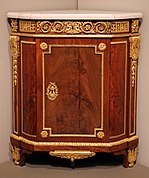
Back طراز لويس السادس عشر Arabic Estil Lluís XVI Catalan Luiséz Czech Louis Seize Danish Louis-seize German Estilo Luis XVI Spanish Louis XVI stiil Estonian Ludvig XVI:n tyyli Finnish Style Louis XVI French Estilo Lois XVI Galician
Left to right, top to bottom: Salon Doré of Marie Antoinette, Chateau de Versailles; Armchair by Georges Jacob, Chateau of Versailles; Château de Bagatelle (1777); Corner cabinet by Jean-Henri Riesener (1785); Toile de Jouy printed fabric, with balloon design (1784) | |
| Years active | 1774–1789 |
|---|---|
| Location | France |
Louis XVI style, also called Louis Seize, is a style of architecture, furniture, decoration and art which developed in France during the 19-year reign of Louis XVI (1774–1792), just before the French Revolution. It saw the final phase of the Baroque style as well as the birth of French Neoclassicism. The style was a reaction against the elaborate ornament of the preceding Baroque period. It was inspired in part by the discoveries of Ancient Roman paintings, sculpture and architecture in Herculaneum and Pompeii. Its features included the straight column, the simplicity of the post-and-lintel, the architrave of the Greek temple. It also expressed the Rousseau-inspired values of returning to nature and the view of nature as an idealized and wild but still orderly and inherently worthy model for the arts to follow.[1]
Notable architects of the period included Victor Louis (1731–1811), who completed the Grand Théâtre de Bordeaux (1780). The Odeon Theatre in Paris (1779–1782) was built by Marie-Joseph Peyre (1730–1785) and Charles de Wailly (1729–1798). François-Joseph Bélanger completed the Chateau de Bagatelle in just sixty-three days to win a bet for its builder, the King's brother. Another period landmark was the belvedere of the Petit Trianon, built by Richard Mique. The most characteristic building of the late Louis XVI residential style is the Hôtel de Salm in Paris (now the Palais de la Légion d'Honneur), built by Pierre Rousseau in 1751–1783.
Superbly crafted desks and cabinets were created for the Palace of Versailles and other royal residences by cabinetmakers Jean-Henri Riesener and David Roentgen, using inlays of fine woods (particularly mahogany) and decorated with gilded bronze and mother of pearl. Equally fine sets of chairs and tables were made by Jean-Henri Riesener and Georges Jacob.[2]
The royal tapestry works of Gobelins, Aubusson and Beauvais continued to make large tapestries, but an increasing part of their business was the manufacture of upholstery for the new sets of chairs, sofas and other furnishings for the royal residences and nobility. Wallpaper also became an important part of interior design, thanks to new processes developed by Reveillon.
In Hungary, it is known as Copf Style.
- ^ "Louis XVI style". Encyclopædia Britannica.
- ^ "Louis XVI style". Marc Maison.
© MMXXIII Rich X Search. We shall prevail. All rights reserved. Rich X Search




